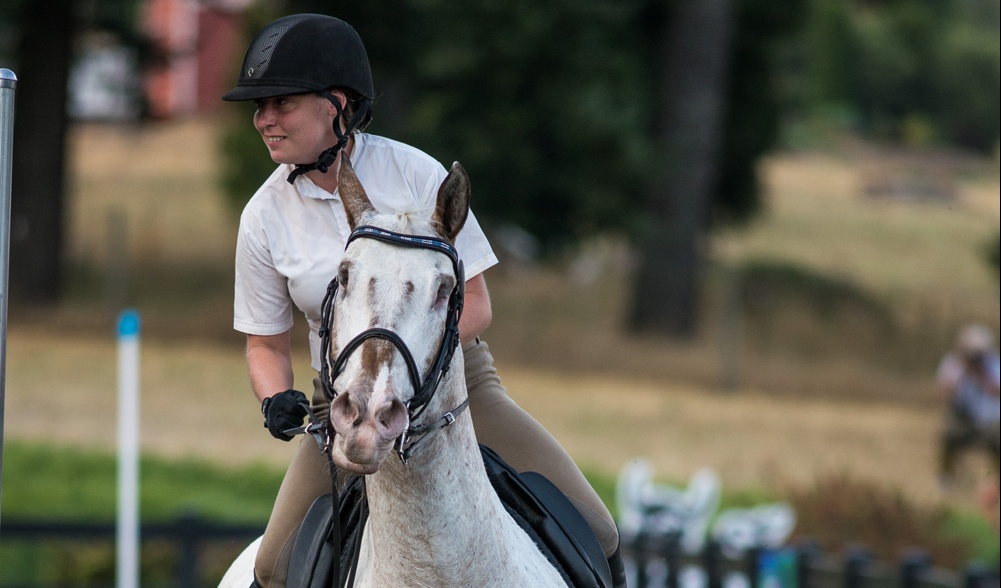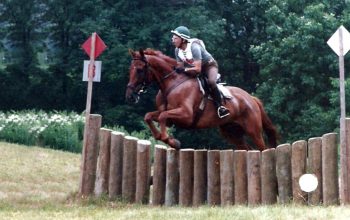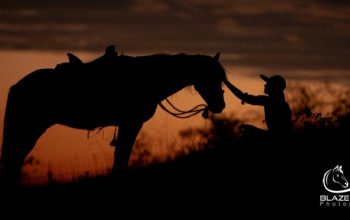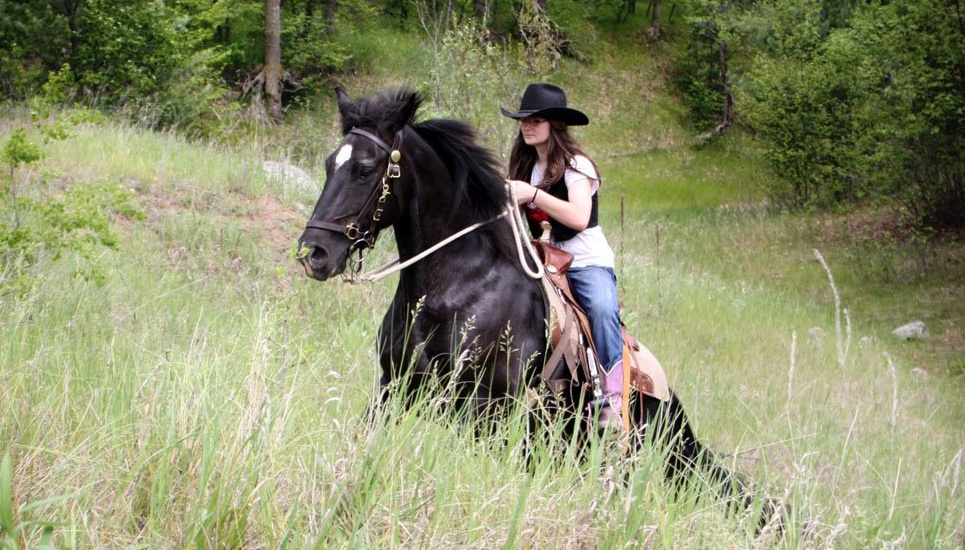Inspiring a World of Horse Lovers
By Morgan Wagner and Jen Wenzel
Story photos by Fearless Photography
Endo was gifted to Morgan Wagner by her grandmother when she was thirteen years old. A breeder of Appaloosas’ and Quarter horses, Morgan’s grandmother gave her young grand-daughter her choice of her foals. Morgan chose Endo, an Appaloosa, drawn to him because of his unique coloring and the strength of his personality, which was quite apparent, even before he was weaned. When Endo arrived at Morgan’s house he knew nothing about being handled and Morgan didn’t know much about how to handle a horse. Through a lot of trial and error and a fair bit of self-study this determined pair learned together and began to form a lasting partnership. Together, Endo and Morgan tried everything. They trail rode for hours every other day, jumped, gamed, and even dove into liberty and trick work. Quite literally, Endo and Morgan learned together every step of the way.
“Do not judge me for my disability, but rather my ability.”
When Endo was 8, his eyes flared up with the painful onset of what was later diagnosed as a combination of recurrent uveitis, glaucoma, and cataracts. His flare ups happened more often the longer his disease went on. Endo’s veterinarian was consulted for every flare with the goal being to preserve his sight. Eventually, Endo stopped eating because of the constant pain. This once gregarious horse would hide in the corner of his stall to get away from the light. He was put on aspirin daily to try and prevent the flares ups that were happening a few times a month, but the medication upset his stomach and he wouldn’t eat. When Morgan would try to tempt him with a carrot or grass he would bite, but just hold the food in his mouth. Endo wasn’t happy. Before his eye conditions took over his life, eating had been one of his favorite activities. Morgan struggled to figure out how to best care for her horse. Finally, Endo’s left eye had a flare up that was beyond any treatment option, and in consultation with the veterinarian, Morgan made the the difficult decision to remove his eye. At the same time as the first surgery, the vet instructed Morgan to prepare Endo for the loss of his other eye, as that too was imminent.
Knowing Endo would eventually lose his right eye too, Morgan decided to become proactive in his education to function as a blind horse. Morgan began by placing a blindfold over Endo’s right eye. He reacted with complete fear, his whole body shook, and he was terrified to take a step. Morgan stood next to him, petting him and reassuring him. After 10 minutes, Endo was brave enough to take a few steps, and Morgan then removed the blindfold. At the next session, Endo had already decided that he could trust Morgan, and she was able to lead him around with confidence. On the third day, they attempted to lunge just at a walk. Unexpectedly, Endo was dizzy. Apparently, with just one badly damaged completely blind eye, he must have been able to see a tiny bit of light, which helped him maintain his balance. Ever the quick learner, Endo figured out how to remove the blindfold before that session was over!
 Morgan also set to work on researching and preparing Endo for a simple life being content and safe with his surroundings. She rescued a miniature mare named Cinnamon to be Endo’s companion because every horse deserves to be part of a herd.
Morgan also set to work on researching and preparing Endo for a simple life being content and safe with his surroundings. She rescued a miniature mare named Cinnamon to be Endo’s companion because every horse deserves to be part of a herd.
Almost before she could believe it, time ran out, and the remaining eye needed to be removed. A few hours after surgery Endo was turning around in his stall as if he could see. Was it memory of the walls, or could he sense them? The vet instructed Morgan to return Endo to his normal life ASAP. Morgan started with small objectives, and found that Endo exceeded them after a few attempts. Morgan used his previous tricks as tools. Endo knew the Spanish walk before going blind, using the cue word “leg.” Morgan adapted that cue to teach Endo to step over small rises or onto obstacles like the horse trailer.
Endo’s balance was the pair’s first real challenge. They again relied on their past experiences together with liberty work to help them conquer the balance obstacle. In the beginning, they started with large circles at a walk, and since Endo was at liberty, his freedom helped both of them stay safe when he got a little wobbly. Morgan used the voice commands she had previously used to instruct Endo in direction for liberty work to give him help knowing what he needed to do. An example of the tools used was a “pick up shoulder” cue word. Endo sometimes became disorientated and fell inside the circle, Morgan would use the cue word to pick his shoulder up and widen the circle. After months of practice, Endo was cantering small circles around Morgan, and she felt he was safe enough to ride circles again.
Their next challenge was exploring the world away from the barn. Endo was scared to go far from his mini mare and the safety of his predictable barn. Morgan believed Endo needed to be a safe horse for others to be around, and these experience were going to help.
So they pushed through it, again using liberty work and voice commands. Using the voice commands and newly relearned lunging work, Morgan kept Endo occupied with work when he started to get nervous about venturing out into new territory. When Endo mentally came back to Morgan, he was rewarded with pets and affection, rewards that had always been used for his training. Endo will do anything for the words “good boy”!
It wasn’t long before Endo blew past Morgan’s hopes of ambling down the local trails again by galloped willingly through the woods with ears perked looking forward onto the unexplored trails. Morgan knew then that she had made the right choice, Endo could be happy again, enjoying doing what every normal horse could.
 A year after his blindness, their home barn hosted a WE United clinician named Julie Alonzo, who came to teach about working equitation (WE). WE has 4 phases: dressage, ease of handling, speed and cattle work. The 4th phase is rarely an option at lower level shows that do not have teams in competition. Morgan and Endo were hooked immediately. Not only does WE test riders on their ability to finely control their horses around obstacles in a dressage form, the sport presented challenges never thought of by Morgan, and Endo enjoys working and learning the new skills.
A year after his blindness, their home barn hosted a WE United clinician named Julie Alonzo, who came to teach about working equitation (WE). WE has 4 phases: dressage, ease of handling, speed and cattle work. The 4th phase is rarely an option at lower level shows that do not have teams in competition. Morgan and Endo were hooked immediately. Not only does WE test riders on their ability to finely control their horses around obstacles in a dressage form, the sport presented challenges never thought of by Morgan, and Endo enjoys working and learning the new skills.
Soon after Morgan and Endo had started their WE career, a theater production in Canada needed a ghost horse and they heard about Endo. Morgan was thrilled with the unbelievable opportunity but worried how Endo would cope living away from home for a few months. He traveled out to shows well, but this was just going to be the next step up.
In Canada, Endo arrived to a huge pasture of his own, and Morgan learned more of his abilities. In the beginning of their travels, Morgan would guide him around the walls of his new stalls, showing him his surrounding before un-haltering him. This time, Morgan undid his halter and stood back to see what he would do. This pasture was far too big to show him around. He walked around eating grass with no fear, walked around the trees and walked along the fence line. He could sense his surroundings without touching them. Morgan had always thought Endo used memory at home to sense his surroundings, but this proved it was something more extraordinary and invisible to us. He even chose the same tree to sleep under each night. Endo loved the theater work. He even learned to follow his cue when the stage helper said “Morgan go” and would throw a little fit when held back. There, he also learned applause meant he did his job well, and he would often offer some unexpected crowd-pleasing flare when he got excited over the clapping.

In the past year, Morgan and Endo have been on adventures all over the country competing, performing and just having fun galloping around new terrain, riding with just a neck strap. Every challenge presented has been an opportunity to showcase Endo’s heart to overcome and conquer challenges placed in front of him. His journey has quite literally shown the world that a blind horse has options beyond euthanasia or being retired as a pasture pet. It’s not just Endo’s ability to overcome his disability but it’s a testament to Morgan’s heart and devotion to her beloved equine. Endo’s story has inspired thousands. On a recent trip from Oregon to Kentucky, where Endo was one of the featured performers at the 2016 BreyerFest, Endo’s Facebook fans accelerated beyond the 50,000 mark, a number that continues to grow as people share his story world wide.
This popularity, and Endo’s inspirational story of love and achievement, has also helped bring him to the attention of some corporate sponsors as well as private donors. Waller Farms, of Beaumont, Texas, made the trip to Kentucky possible with their sponsorship, and La Victoria Performance provides him with equine supplements. Their Go Fund Me campaign helps offset travel expenses and competition costs. “I can’t tell you how much I appreciate all those who have helped us along the way,” explains Endo’s owner Morgan Wagner. “It’s wonderful how many people have contributed to Endo’s success.”
Endo the Blind and Morgan are now training in preparation for competing in the open breed Working Equitation division at both the IALHA Nationals in Utah and the Andalusian World Cup in Las Vegas, Nevada, both of which will take place in September.
 You can find videos and follow them online by searching for “Endo the Blind”. Endo the Blind has his own Facebook page with over 50k followers, and Morgan is working on developing a website for him as well (stay tuned!).
You can find videos and follow them online by searching for “Endo the Blind”. Endo the Blind has his own Facebook page with over 50k followers, and Morgan is working on developing a website for him as well (stay tuned!).
Update: since originally publishing this story in Sport and Trail’s Septmeber 2016 issue, Endo’s Facebook Fan list has grown to over 137k followers. Way to go, Endo!





